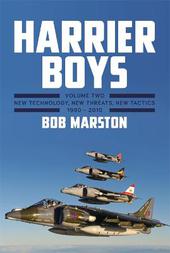
|
Harrier Boys: Volume Two: New Threats, New Technology, New Tactics, 1990 - 2010
Hardback
Main Details
| Title |
Harrier Boys: Volume Two: New Threats, New Technology, New Tactics, 1990 - 2010
|
| Authors and Contributors |
By (author) Bob Marston
|
| Physical Properties |
| Format:Hardback | | Pages:192 | | Dimensions(mm): Height 234,Width 156 |
|
| Category/Genre | British and Irish History |
|---|
| ISBN/Barcode |
9781910690178
|
| Classifications | Dewey:358.43830941 |
|---|
| Audience | |
|---|
|
Publishing Details |
| Publisher |
Grub Street Publishing
|
| Imprint |
Grub Street Publishing
|
| Publication Date |
29 July 2016 |
| Publication Country |
United Kingdom
|
Description
In the second volume of Harrier Boys, as with the first, the history of this remarkable aircraft in service with UK armed forces is illustrated through personal reminiscences of the people who worked with it. The book begins with explanations of the mature concept of operations with the Harrier GR3 in the Cold War. It then progresses through the evolution of Harrier II, starting with the GR5, and updates to the Sea Harrier, while the potential battles to be fought necessitated ever-changing tactics and technology. The new Harriers used digital developments for airframe, engine and weapons control. Conflicts in Iraq, Bosnia, Kosovo, Sierra Leone and Afghanistan saw ground-attack missions move towards the delivery of smart weapons from medium level, rather than the dumb bombs and low level of the Cold War era - meaning that the Harrier had once more to demonstrate its legendary versatility. The introduction of the Sea Harrier FA2, with its beyond visual range air-to-air missiles and improved radar, gave much improved air defence. The UK Harrier story ends with the closer integration of the RN and RAF forces, before the aircraft's all-too-early retirement in 2010, possibly decades before other countries forsake this unique capability. AUTHOR: After completing the Harrier course on 233 Operational Conversion Unit, Bob Marston joined 1 (Fighter) Squadron finishing the tour qualified as a fighter reconnaissance instructor. After two years of flying Harrier displays, he became a Hawk qualified flying instructor before returning to Wittering as a Harrier QFI on 233 OCU later being awarded the Air Force Cross. Promoted to squadron leader, he became a flight commander on 3 (Fighter) Squadron based at Gutersloh. Finishing the tour as the squadron executive officer he was awarded the Queen's Commendation for Valuable Service in the Air. Promoted to wing commander, he flew the Jaguar as OC Operations Wing at RAF Coltishall, before moving into the training world at RAF Cranwell, where he was made group captain and became OC 1 Elementary Flying Training School, responsible for all light aircraft flying training for UK armed forces. On retirement he became a reservist flying instructor, eventually completing a forty-year flying career. He flew some 6,400 hours in his RAF career, 3,300 of them in the Harrier. 60 colour and b/w photos
Author Biography
After completing the Harrier course on 233 Operational Conversion Unit, Bob Marston joined 1 (Fighter) Squadron finishing the tour qualified as a fighter reconnaissance instructor. After two years of flying Harrier displays, he became a Hawk qualified flying instructor before returning to Wittering as a Harrier QFI on 233 OCU later being awarded the Air Force Cross. Promoted to squadron leader, he became a flight commander on 3 (Fighter) Squadron based at Gutersloh. Finishing the tour as the squadron executive officer he was awarded the Queen's Commendation for Valuable Service in the Air. Promoted to wing commander, he flew the Jaguar as OC Operations Wing at RAF Coltishall, before moving into the training world at RAF Cranwell, where he was made group captain and became OC 1 Elementary Flying Training School, responsible for all light aircraft flying training for UK armed forces. On retirement he became a reservist flying instructor, eventually completing a forty-year flying career. He flew some 6,400 hours in his RAF career, 3,300 of them in the Harrier.
|